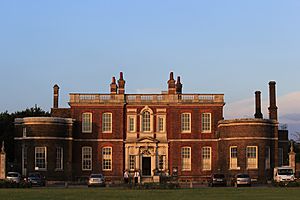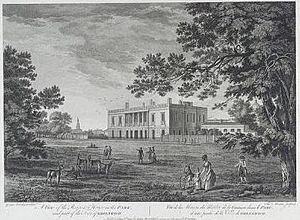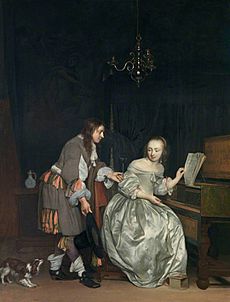Ranger's House facts for kids
Quick facts for kids Ranger's House |
|
|---|---|

Ranger's House, seen from Shooters Hill Road
|
|
| Type | Mansion |
| Location | Blackheath |
| OS grid reference | TQ 38887 76832 |
| Area | Greater London |
| Built | c. 1722 |
| Architect | John James |
| Architectural style(s) | Palladian |
| Owner | English Heritage |
|
Listed Building – Grade I
|
|
| Official name: The Ranger's House | |
| Designated | 19 October 1951 |
| Reference no. | 1218679 |
| Lua error in Module:Location_map at line 420: attempt to index field 'wikibase' (a nil value). | |
Ranger's House is a beautiful red brick mansion in London, right next to Greenwich Park. It was built in the Palladian style, which is a type of architecture inspired by ancient Roman buildings.
This house is in Blackheath and has a lovely rose garden behind it. It used to be called Chesterfield House. Its current name comes from the "Ranger of Greenwich Park," a special royal job. The house was the Ranger's home for most of the 1800s. Today, it is a Grade I listed building, meaning it's very important historically. Since 2002, it has been home to the Wernher Collection of amazing art.
Contents
History of Ranger's House
The Ranger's House was likely built around 1722 or 1723. It was first built for a naval officer named Francis Hosier. He was a Vice-Admiral, which is a high rank in the navy. Hosier made a lot of money from sea trade. The house was built on land next to Greenwich Park. It had a fantastic view and was easy to reach from London by road and river. Hosier lived in the house until he passed away in 1727 during a naval mission.
Famous Owners and Changes
In 1748, a famous politician and writer, the 4th Earl of Chesterfield, took over the house. He was a very important person in the government. He added a grand gallery with a large curved window. This room was perfect for entertaining guests and showing off his art collection. Chesterfield loved the view from this gallery, saying it offered "three different, and the finest, prospects in the world."
Later, in 1782, Richard Hulse bought the house. He was a businessman who worked with the Hudson's Bay Company. Hulse added another room with a curved window on the other side of the house. This made the house look balanced, just as it does today.
For a short time, from 1807 to 1813, the house was called Brunswick House. This was when the Duchess of Brunswick lived there.
Becoming the Ranger's Home
The Ranger's House first became the official home for the Ranger of Greenwich Park in 1816. Before this, Caroline of Brunswick, who was appointed Ranger in 1806, lived in a nearby house.
Later, in 1888, Queen Victoria invited Field Marshal Lord Wolseley and his family to live in the Ranger's House. It was a much grander home than where they had lived before.
In 1902, the London County Council bought the house. It was then used as a sports club and a place to have tea. The house was also used during both World Wars. In 1937, special blue plaques were put on the house to remember Lord Wolseley and the Earl of Chesterfield. For a while, the house displayed old musical instruments and portraits.
Since 1986, Ranger's House has been looked after by English Heritage.
Who Was the Ranger of Greenwich Park?
The first Ranger was chosen in 1690. This was a royal appointment, meaning the King or Queen chose them. It was often a job that didn't have many duties. For some years, the Ranger also held another important job at the Greenwich Hospital. At first, the Ranger lived in the Queen's House, Greenwich.
Some of the past Rangers included:
- Charles Sackville, 6th Earl of Dorset (appointed 1690)
- Henry Sydney, 1st Earl of Romney (1697)
- Sir William Gifford (1710)
- Matthew Aylmer, 1st Baron Aylmer (1714–1720)
- Sir John Jennings (1720–1743)
- Lady Catherine Pelham (1743–1780)
- Caroline of Brunswick (1805–1813)
- Princess Sophia Mathilda of Gloucester (1813 – 1844)
- Garnet Wolseley, 1st Viscount Wolseley (1888–1896)
The Wernher Collection
The Wernher Collection is a huge collection of art and beautiful objects. It was put together by a very rich diamond businessman named Sir Julius Wernher. He collected these items in the late 1800s and early 1900s. Sir Julius lived in grand homes in London and Bedfordshire.
Today, about 700 items from the Wernher Collection are on display at Ranger's House. They are spread across twelve rooms. Some of these rooms have been decorated to look like how the collection was displayed in Sir Julius's own home.
The collection includes paintings by famous artists like Sandro Botticelli (a painting called "Madonna of the Pomegranate"), Filippino Lippi, Hans Memling, Pieter de Hooch, Gabriël Metsu, and Francesco Francia. There are also portraits by English painters such as Sir Joshua Reynolds, George Romney, and John Hoppner.
Besides paintings, the collection has many different kinds of decorative art. You can see amazing Renaissance jewelry, old ivories from the medieval and Byzantine times, beautiful enamels, bronze statues, Italian pottery, tapestries, furniture, and fancy Sèvres porcelain. There's even a life-sized marble sculpture by Bergonzoli called "The Love of Angels."



